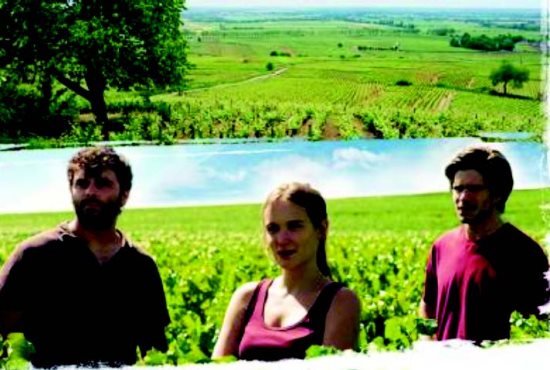 | | | Photo provided | | | | | | After two powerful but dark movies, the International Film Showcase brings a much sweeter feel-good film to Orinda with the French production, "Back to Burgundy." The French title, "Ce qui nous lie," has a double meaning and could be translated to either "what attaches us together" or "what links us," and better expresses the constraints and beauty of the relationships between the three main characters of the movie - three siblings confronted with their father's death. As they deal with their inheritance, both material and psychological, each finds their way into complete adulthood. "Back to Burgundy" is a fundamentally optimistic movie.
 After the premature death of their father, three siblings between 25 and 30 years old are reunited and must decide what to do with the family winemaking farm. The backdrop of the movie is winemaking, but what really interests the director, Cedric Klapisch ("The Spanish Apartment," "Chinese Puzzle"), are the human relationships.
After the premature death of their father, three siblings between 25 and 30 years old are reunited and must decide what to do with the family winemaking farm. The backdrop of the movie is winemaking, but what really interests the director, Cedric Klapisch ("The Spanish Apartment," "Chinese Puzzle"), are the human relationships.
 The movie takes place in the vineyards of Burgundy during a full year of its changing seasons. The family owns some significant vineyard acreage, and the movie takes the spectator beautifully along for the entire cycle of traditional winemaking.
The movie takes place in the vineyards of Burgundy during a full year of its changing seasons. The family owns some significant vineyard acreage, and the movie takes the spectator beautifully along for the entire cycle of traditional winemaking.
 But beyond the anecdotal and documentary-like aspect of the movie, what is at stake here is how three young people, now orphaned, find their way to fulfillment and realization, between tradition and "terroir," as they spread their wings and explore new territories.
But beyond the anecdotal and documentary-like aspect of the movie, what is at stake here is how three young people, now orphaned, find their way to fulfillment and realization, between tradition and "terroir," as they spread their wings and explore new territories.
 Klapisch likes to observe and explore this age, between 20 and 30, when people still have some of their childhood soul inside but are gradually become responsible adults. Much like the wine that takes time to be made, nature follows rhythms that need to be respected, and during that year the three siblings change. Juliette, the middle sister, lacking self-confidence and having doubts about her own abilities, blossoms into a winemaker and a woman. Jean, the eldest that left the farm to live far away comes to terms with his childhood, and JĒrĒmie, the youngest, asserts himself and becomes free from overbearing in-laws.
Klapisch likes to observe and explore this age, between 20 and 30, when people still have some of their childhood soul inside but are gradually become responsible adults. Much like the wine that takes time to be made, nature follows rhythms that need to be respected, and during that year the three siblings change. Juliette, the middle sister, lacking self-confidence and having doubts about her own abilities, blossoms into a winemaker and a woman. Jean, the eldest that left the farm to live far away comes to terms with his childhood, and JĒrĒmie, the youngest, asserts himself and becomes free from overbearing in-laws.
 The movie rings true and will touch spectators in many ways: the film delves into the untold family stories and the misunderstandings that come from lack of communication, the siblings' different perceptions depending on their birth order, and the difficulty asserting one's independence while preserving one's heritage and roots. The movie also broaches contemporary issues such as feminism, ecology and mixing of races.
The movie rings true and will touch spectators in many ways: the film delves into the untold family stories and the misunderstandings that come from lack of communication, the siblings' different perceptions depending on their birth order, and the difficulty asserting one's independence while preserving one's heritage and roots. The movie also broaches contemporary issues such as feminism, ecology and mixing of races.
 The film may be a little slow for an American audience, but people should enjoy the charm of this lovely countryside and the traditional way of making wine. Burgundy vineyards are still owned by families rather than corporations, and making wine is a craft where the personality of the winemakers comes through. In order to realize a movie that is true to that specific craft, Klapisch worked with local farmer-winemakers during the whole year, alongside the actors.
The film may be a little slow for an American audience, but people should enjoy the charm of this lovely countryside and the traditional way of making wine. Burgundy vineyards are still owned by families rather than corporations, and making wine is a craft where the personality of the winemakers comes through. In order to realize a movie that is true to that specific craft, Klapisch worked with local farmer-winemakers during the whole year, alongside the actors.
 The director, who also wrote the movie, explained that the film was actually shot over a full year, during four different sets of weeks, and that the scenario evolved one season after another.
The director, who also wrote the movie, explained that the film was actually shot over a full year, during four different sets of weeks, and that the scenario evolved one season after another.
 "Back to Burgundy" will play at the Orinda Theatre for one week, starting on May 4. For more information, visit lamorindatheatres.com.
"Back to Burgundy" will play at the Orinda Theatre for one week, starting on May 4. For more information, visit lamorindatheatres.com.


|
